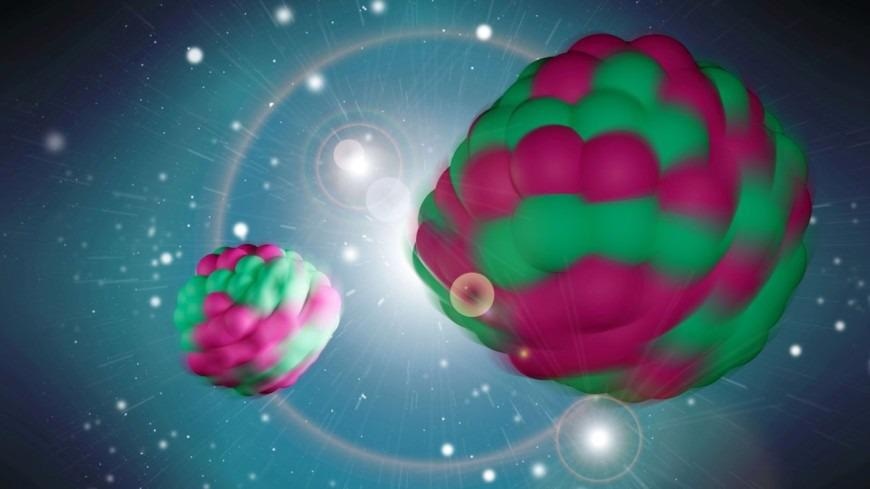Feb 26 2021
A set of experiments performed at the ALTO particle accelerator facility based in Orsay, France, has demonstrated that the fragments ensuing from nuclear fission achieve their inherent angular momentum (or spin) only after the fission reactions and not before them, as is generally believed.
 Rotating fragments after nuclear fission (artist view). Image Credit: Technische Universitat Darmstadt.
Rotating fragments after nuclear fission (artist view). Image Credit: Technische Universitat Darmstadt.
This latest finding was made possible by the 'nu-ball' partnership, an international team of nuclear physicists from 16 nations and 37 institutes—and among them are researchers from the Institute of Nuclear Physics of Technische Universitat Darmstadt (TU Darmstadt)—which explored an extensive range of nuclei and associated structures.
The Irène-Joliot-Curie Laboratory in Orsay has headed the collaboration.
Open Questions Since the 1930s
In nuclear fission reactions, a heavy nucleus breaks into two and discharges energy. This phenomenon was already discovered toward the end of the 1930s by chemists Otto Hahn and Fritz Strassmann, and was precisely understood by physicists Lise Meitner and Otto Frisch.
But open questions about the nuclear fission process still persist even today. The latest scientific analysis tackles the question of why—when a heavy atomic nucleus undergoes a fission reaction—the ensuing fragments tend to spin, even when the original nucleus did not rotate at all.
Several competing theories exist, but according to most of these theories, the spin of the fission fragments is produced before the nucleus actually splits, resulting in a distinct correlation of the spins of both partner fragments.
More Than Thousand Hours of Beamtime
To demonstrate the mechanism that generates the fragment spin, nuclear fission reactions were induced at the ALTO facility and gamma rays were measured; these gamma rays are discharged during the process with 'nu-ball' containing a total of 184 detectors.
At the ALTO particle accelerator, over 1200 hours of beamtime were available to irradiate the samples of the thorium isotope 232Th and the uranium isotope 238U with a beam of pulsed neutrons.
TU Darmstadt researchers also helped in the preparation of the experiment, took part in the measurements, examined the chosen data, and played a role in the scientific discussion.
My group at TU Darmstadt contributed the huge experience with fast scintillation detectors in combination with germanium detectors to investigate fission fragments. However, this experiment enabled for the first time to address also the dynamics of the fission process which proceeds on a 10-21 seconds time scale inaccessible for any direct observation.
Dr Thorsten Kröll, Professor, Technische Universitat Darmstadt
The latest, in-depth data revealed that the spin in fission is, in fact, produced after the breakdown of the nucleus. This phenomenon is denoted by the analysis of the quantified gamma rays.
The experiments demonstrated that the average spin has a saw-tooth reliance on the fragment mass. But the two fragments, which can break into different mass ratios, have only average spins which do not seem to rely on the mass of their partner fragment.
What really surprised me was the lack of significant dependence of the average spin observed in one fragment on the minimum spin demanded in the partner fragment. Most theories hypothesizing that spin is generated before fission would have predicted a strong correlation. Our results show that the fragment spin emerges after the splitting. It can be illustrated with by the snapping of a stretched elastic band which results in a turning force, or torque.
Dr Jonathan Wilson, Study Main Author, IJC Laboratory, Orsay
Expertise from TU Darmstadt
Such experiments turned out to be viable on the basis of the experience gained in earlier projects aiming at instant spectroscopy of fission fragments using multi-detector spectrometers, in which TU Darmstadt scientists have already contributed their know-how in data analysis and detector technology.
New Horizons for Physics Research
This latest understanding of the role of angular momentum in nuclear fission is crucial for theoretical description and basic interoperation of the fission process. But they also have implications for other areas of research works, like the development and stability of super-heavy elements and the analysis of the structure of neutron-rich isotopes.
There are also implications for practical applications, like the gamma-ray heating issue observed in nuclear reactors. A better understanding of the gamma rays generated in nuclear fission (and parameters, like the number of gamma rays produced) is significant for estimating the heating effects.
Such experiments also pave the way for experiments with neutrons from laser-fueled neutron sources, as they are being developed at TU Darmstadt within the LOEWE Research Cluster 'Nuclear Photonics.'
Journal Reference:
Wilson, J. N., et al. (2021) Angular momentum generation in nuclear fission. Nature. doi.org/10.1038/s41586-021-03304-w.